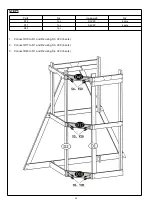
9
IMPORTANT CONSUMER INFORMATION SHHET
The following guidelines are extracts from the Consumer Product Safety Commission Outdoor Home
Playground Safety Handbook. It is recommended that you read the entire handbook and take necessary
precautions to prevent serious injuries to your children, including:
CHOOSING A SITE
When you choose a home playground, a location away from roads and driveways and readily visible from inside
the home and patios or porches, is important.
Create a site free of obstacles that could cause injuries such as low overhanging tree branches, overhead
wires, tree stumps and/or roots, large rocks, bricks and concrete.
Choose a level location for the equipment. This can reduce the likelihood of the play set tipping over and
loose-fill surfacing materials washing away during heavy rains. Some sites may need regrading to improve
drainage or to reduce the slope.
Locate play equipment at least 6 feet from any structure or obstacles, such as a house, fence, sheds, trees or
poles. Swings should be further away from structures to the front and rear of the swings a distance equal to
twice the height of the top bar from which the swing is suspended.
Locate bare metal platforms and slides out of direct sunlight to reduce the likelihood of serious burns. A slide
that faces north will receive the least direct sunlight.
SELECT PROTECTIVE SURFACING
One of the most important things you can do to reduce the likelihood of serious head injuries is to install
shock-absorbing protective surfacing under and around your play equipment. The protective surfacing should be
applied to a depth that is suitable for the equipment height in accordance with ASTM F1292. There are different
types of surfacing to choose from; whichever product you select, follow these guidelines:
Do not install home playground equipment over concrete, asphalt, or any other hard surface. A fall onto a
hard surface can result in serious injury to the equipment user. Grass and dirt are not considered protective
surfacing because wear and environmental factors can reduce their shock absorbing effectiveness.
Carpeting and thin mats are generally not adequate protective surfacing.
Loose-Fill Materials
Maintain a minimum depth of 9 inches of loose-fill materials such as wood mulch/chips, engineered wood fiber
(EWF), or shredded/recycled rubber mulch for equipment up to 8 feet high; and 9 inches of sand or pea gravel
for equipment up to 5 feet high. NOTE: An initial fill level of 12 inches will compress to about a 9-inch depth of
surfacing over time. The surfacing will also compact, displace, and settle, and should be periodically refilled to
maintain at least a 9-inch depth.
Use containment, such as digging out around the perimeter and/or lining the perimeter with landscape edging.
Don’t forget to account for water drainage.
Summary of Contents for 157042
Page 14: ...13 COMPLETE PRODUCT VIEW FRONT VIEW OF COMPLETE PRODUCT BACK VIEW OF COMPLETE PRODUCT ...
Page 16: ...15 WOOD PARTS LIST ...
Page 17: ...16 WOOD PARTS LIST ...
Page 18: ...17 WOOD PARTS LIST ...
Page 20: ...19 COMPONENT PARTS LIST ...
Page 29: ...28 STEP 9 Part Qty Hardware Qty NA S4 V20 2 sets 1 Connect D20 to D17 using S4 V20 2 sets ...
Page 34: ...33 STEP 14 Part Qty Hardware Qty D38 3 pcs S5 6 pcs 1 Connect D38 to D37 using S5 6 pcs ...
Page 47: ...46 STEP 27 Part Qty Hardware Qty U5 2 sets NA 1 Attach the swing seat to the frame ...
Page 50: ...49 STEP 30 Part Qty Hardware Qty U641 1 pc S9 7 pcs 1 Connect U641 on the top using S9 7 pcs ...









































